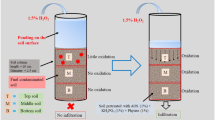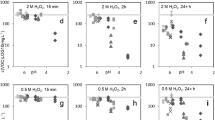Abstract
Number 6 fuel oil is one of the most used energy sources for electricity generation. However, leaks can contaminate soil and also groundwater due to leaching. At old sites, the oil may have low toxicity but still contaminate groundwater with foul-tasting compounds even at low concentrations. The purpose of this study was to evaluate the feasibility of applying H2O2 to reduce the leaching potential of a fuel oil contaminated soil. A silt-loam soil was collected from a contaminated thermal-electric plant with a hydrocarbon concentration of 3.2% in soil producing 4.3 mg/l in leachate. Hydrogen peroxide was applied (0.1, 0.2, 0.3, 0.6, 1.2% dry weight basis), and petroleum hydrocarbons were measured in soil and leachate pre- and post-treatment (72 h). At first, the soil and leachate concentrations diminished linearly (24.4 and 27.3% in soil and leachate, respectively). This was followed by a phase in which the concentration in leachate diminished greatly (75.8%) although the concentration in soil was reduced only moderately (15.1%). Overall, hydrocarbons in leachates were reduced 82.4% even though concentrations in soil were only reduced 35.8%. Correlation analysis showed that at only 1.0% w/w H2O2 a concentration of petroleum hydrocarbons in leachate safe for human consumption (≤ 1 mg/l) could be obtained even with a final hydrocarbon concentration in soil > 2%. Thus, this study presents an alternative strategy for remediation of fuel oil contaminated soils in urban environments that protects water sources by focusing on contamination in leachates, without spending extra financial resources to reduce the hydrocarbon concentration in low-toxicity soil.






Similar content being viewed by others
References
AASHTO (2015) AASHTO T 180 Standard Method of Test for Moisture-Density Relations of Soils Using a 4.54-kg (10-lb) Rammer and a 457-mm (18-in.) Drop. American Association of State Highway and Transportation Officials, 01 Jan 2015, Washington D.C., USA, p 14
Adams RH, Guzmán-Osorio FJ (2008) Evaluation of land farming and chemico-biological stabilization for treatment of heavily contaminated sediments in a tropical environment. Int J Environ Sci Technol 5:169–178
Adams RH, Morales-García F (2008) Concentración Residual de Hidrocarburos en Suelo del Trópico. I: consideraciones Para la Salud Pública y Protección al Ganado. Interciencia 33:476–482
Adams RH, Guzmán FJ, Zavala J (2008a) Water repellency in oil contaminated sandy and clayey soils. Int J Environ Sci Technol 5:445–454
Adams RH, Morales-García FA, Zavala-Cruz J (2008b) Concentración residual de hidrocarburos en suelo del trópico. II: afectación a la fertilidad y su recuperación. Interciencia 33:483–489
Adams RH, Guzmán-Osorio FJ, Domínguez-Rodríguez VI (2014) Field-scale evaluation of the chemical–biological stabilization process for the remediation of hydrocarbon-contaminated soil. Int J Environ Sci Technol 11:1343–1352
Adams RH, Cerecedo-López RA, Alejandro-Álvarez LA et al (2016) Treatment of water-repellent petroleum-contaminated soil from Bemidji, Minnesota, by alkaline desorption. Int J Environ Sci Technol 13:2249–2260
Al-Sarawi M, Massoud MS, Al-Abdali F (1998) Preliminary assessment of oil contamination levels in soils contaminated with oil lakes in the greater burgan oil fields, Kuwait. Water Air Soil Pollut 106:493–504
Astbury GR (2002) Safe scale-up of oxidation by hydrogen peroxide in flammable solvents. Org Process Res Dev 6:893–895
ASTM (1995) Standard Guide for Risk-Based Corrective Action Applied at Petroleum Release Sites. American Society for Testing and Materials. West Conshohocken, PA, USA. www.astm.org/Standards/E1739.htm
Bañón-Blázquez L, Beviá-García JF (2000) Manual de carreteras. Volumen II: construcción y mantenimiento. Universidad de Alicante, Alicante
British Petroleum (2011) Fuel oil safety data sheet. http://www.bp.com/content/dam/bp-marine/en/documents/USA-RMGtoRMK.pdf. Accessed 17 April 2017
Chaîneau CH, Morel JL, Oudot J (1996) Land treatment of oil-based drill cuttings in an agricultural soil. J Environ Qual 25:858–867
Chaîneau CH, Morel JL, Oudot J (2000) Vertical infiltration of fuel oil hydrocarbons in an agricultural soil. Toxicol Environ Chem 74:111–124
Chaîneau CH, Yepremian C, Vidalie JF et al (2003) Bioremediation of a crude oil-polluted soil: biodegradation, leaching and toxicity assessments. Water Air Soil Pollut 144:419–440
Chen J-R, Chen S-K (2005) Experimental studies of ignition and explosions in cyclohexane liquid under oxygen oxidation conditions. J Loss Prev Process Ind 18:97–106
Davies BE (1974) Loss-on-ignition as an estimate of soil organic matter. Soil Sci Soc Am J 38:150–151
Dekker LW, Jungeris PD (1990) Water repellency in the dunes with special reference to The Netherlands. Catena Suppl 18:173–183
Ezra S, Feinstein S, Pelly I et al (2000) Weathering of fuel oil spill on the east Mediterranean coast, Ashdod, Israel. Org Geochem 31:1733–1741
Farzadkia M, Dehghani M, Moafian M (2014) The effects of Fenton process on the removal of petroleum hydrocarbons from oily sludge in Shiraz oil refinery, Iran. J Environ Heal Sci Eng 12:1–7
Fernández LC, Rojas NG, Roldán TG et al (2006) Manual de técnicas de análisis de suelos aplicadas a la remediación de sitios contaminados. Instituto Mexicano del Petróleo, Mexico City
Garcia PV, Linhares D, Amaral AFS, Rodrigues AS (2012) Exposure of thermoelectric power-plant workers to volatile organic compounds from fuel oil: genotoxic and cytotoxic effects in buccal epithelial cells. Mutat Res Toxicol Environ Mutagen 747:197–201
Goi A, Kulik N, Trapido M (2006) Combined chemical and biological treatment of oil contaminated soil. Chemosphere 63:1754–1763
Goi A, Trapido M, Kulik N (2009) Contaminated soil remediation with hydrogen peroxide oxidation. Int Sch Sci Res Innov 3:209–213
González JM (2009) La generación eléctrica a partir de combustibles fósiles. Boletín Inst Investig Eléctricas 33:143–151
Guzmán RA, Sánchez S, García E (2007) Efecto de los residuos de una industria cerámica sobre la contaminación del suelo. Rev Ciencias Técnicas Agropecu 16:46–52
Haag WR, Yao CCD (1992) Rate constants for reaction of hydroxyl radicals with several drinking water contaminants. Environ Sci Technol 26:1005–1013
ITRC (2005) Technical and regulatory guidance for in situ chemical oxidation of contaminated soil and groundwater. Interstate Technology & Regulatory Council—In Situ Chemical Oxidation Team, Washington D.C., USA
King PM (1981) Comparison of methods for measuring severity of water repellence of sandy soils and assessment of some factors that affect its measurement. Aust J Soil Res 19:275–285
Kong S-H, Watts RJ, Choi J-H (1998) Treatment of petroleum-contaminated soils using iron mineral catalyzed hydrogen peroxide. Chemosphere 37:1473–1482
Koolivand A, Naddafi K, Nabizadeh R et al (2014) Application of hydrogen peroxide and fenton as pre- and post-treatment steps for composting of bottom sludge from crude oil storage tanks. Pet Sci Technol 32:1562–1568
Leelamanie DAL, Karube J (2009) Effects of hydrophobic and hydrophilic organic matter on the water repellency of model sandy soils. Soil Sci Plant Nutr 55:462–467
Lim MW, Von Lau E, Poh PE (2016) A comprehensive guide of remediation technologies for oil contaminated soil—present works and future directions. Mar Pollut Bull 109:14–45
Litvina M, Todoruk TR, Langford CH (2003) Composition and structure of agents responsible for development of water repellency in soils following oil contamination. Environ Sci Technol 37:2883–2888
López F, Martínez VE (2001) Efecto de hidrocarburos en las propiedades físicas y químicas de suelo arcilloso. Terra Latinoam 19:9–17
López R, Tentle MA (2012) Análisis de los desplazamientos horizontales observados con GPS en el occidente de la cuenca de México. Universidad Nacional Autónoma de México, Mexico
Marín-García DC, Adams RH, Hernández-Barajas R (2016) Effect of crude petroleum on water repellency in a clayey alluvial soil. Int J Environ Sci Technol 13:55–64
Menendez-Vega D, Gallego JLR, Pelaez AI et al (2007) Engineered in situ bioremediation of soil and groundwater polluted with weathered hydrocarbons. Eur J Soil Biol 43:310–321
Morales-Bautista CM, Adams RH, Guzmán-Osorio F, Marín-García D (2013) Dilution-extrapolation hydrometer method for easy determination of API gravity of heavily weathered hydrocarbons in petroleum contaminated soil. Energy Environ Res 3:115–124
Nakaya N, Motomura S, Yokoi H (1977) Some aspects on water repellency of soils. Soil Sci Plant Nutr 23:409–415
Ojinnaka C, Osuji L, Achugasim O (2012) Remediation of hydrocarbons in crude oil-contaminated soils using Fenton’s reagent. Environ Monit Assess 184:6527–6540
Petigara BR, Blough NV, Mignerey AC (2002) Mechanisms of hydrogen peroxide decomposition in soils. Environ Sci Technol 36:639–645
Pignatello JJ, Oliveros E, MacKay A (2006) Advanced oxidation processes for organic contaminant destruction based on the Fenton reaction and related chemistry. Crit Rev Environ Sci Technol 36:1–84
Quan HN, Teel AL, Watts RJ (2003) Effect of contaminant hydrophobicity on hydrogen peroxide dosage requirements in the Fenton-like treatment of soils. J Hazard Mater 102:277–289
Riser-Roberts E (1998) Remediation of petroleum contaminated soils: biological, physical, and chemical processes. CRC Press, Boca Raton
Ruíz-Saucedo U (2006) Guía Técnica para Orientar la Elaboración de Estudios de Evaluación de Riesgo Ambiental de Sitios Contaminados. Secretaría de Medio Ambiente y Recursos Naturales, Dirección General de Gestión Integral de Materiales y Actividades Riesgosas (DGGIMAR). México, D.F.
SEMARNAT (1993) Norma Oficial Mexicana NOM-053-SEMARNAT-1993, que estableceque establece el procedimiento para llevar a cabo la prueba de extracción para determinar los constituyentes que hacen a un residuo peligroso por su toxicidad al ambiente. Secretaría de Medio Ambiente y Recursos Naturales, Diario Oficial de la Federación, 22 Oct 1993, Mexico City, Mexico, p 24
SEMARNAT (2002) Norma Oficial Mexicana NOM-021-SEMARNAT-2000, que establece las especificaciones de fertilidad, salinidad y clasificación de suelos, estudio, muestreo y análisis. Secretaría de Medio Ambiente y Recursos Naturales, Diario Oficial de la Federación, 31 Dec 2002, Mexico City, Mexico, p 85
SEMARNAT (2007) Oficio No. DGGIMAT. 710/006805. Resolutivo del Programa de Remediación para la Restauración en el sitio del pasivo ambiental de Texistepec, Veracruz (Presa Agua de Mina, Unidad Minera Texistepec). Secretaría de Medio Ambiente y Recursos Naturales, Dirección General de Gestión Integral de Materiales y Actividades Riesgosas (DGGIMAR). Mexico, D.F. 22 Oct 2007
SEMARNAT (2013) Norma Oficial Mexicana NOM-138-SEMARNAT/SSA1-2012, que establece los límites máximos permisibles de hidrocarburos en suelos y lineamientos para el muestreo en la caracterización y especificaciones para la remediación. Secretaría de Medio Ambiente y Recursos Naturales, Diario Oficial de la Federación, 10 Sept 2013, Mexico City, Mexico, 14p
Teutli León MMM, Ruíz Tagle AC, Rodríguez Zamora K et al (2003) Remediación en suelos contaminados por hidrocarburos y de lodos de recorte mediante electrólisis, compuestos oxidantes y zeolitas naturales. Tecnol Ciencia Educ 18:81–89
Tsai TT, Kao CM (2009) Treatment of petroleum-hydrocarbon contaminated soils using hydrogen peroxide oxidation catalyzed by waste basic oxygen furnace slag. J Hazard Mater 170:466–472
Tsai TT, Kao CM, Yeh TY et al (2009a) Remediation of fuel oil-contaminated soils by a three-stage treatment system. Environ Eng Sci 26:651–659
Tsai TT, Kao CM, Surampalli RY, Chien HY (2009b) Enhanced bioremediation of fuel-oil contaminated soils: laboratory feasibility study. J Environ Eng 135:845–853
Vorhees DJ, Weisman WH, Gustafson JB (1999) Human health risk-based evaluation of petroleum release sites: implementing the working group approach. Total petroleum hydrocarbon criteria working group series, vol 5. Amherst Scientific Publishers, Amherst
WDEQ (2014) Fact Sheet #12 Soil Cleanup Levels. Wyoming Department of Environmental Qualitiy, Voluntary Remediation Program, 12 Feb 2014, Cheyenne, Wyoming, USA, p 24
Zavala-Cruz J, Gavi-Reyes F, Domínguez-Ezquivel JM et al (2005) Derrames de petróleo en suelos y adaptación de pastos tropicales en el Activo Cinco Presidentes, Tabasco, México. Terra Latinoam 23:293–302
Acknowledgements
We would like to thank the non-profit organization Centro de Investigación Balam-Europeo, A.C. for economic support for this project (Project No. CIB-2016-001), as well as Jorge Cano, Rubén Viornery and Analleli Romero for logistical support.
Author information
Authors and Affiliations
Corresponding author
Additional information
Editorial responsibility: J. Aravind.
Rights and permissions
About this article
Cite this article
Romero-Frasca, E., Adams, R.H. & Domínguez-Rodríguez, V.I. Reducing leachable petroleum hydrocarbon concentration in weathered fuel oil contaminated soil by chemical oxidation with hydrogen peroxide. Int. J. Environ. Sci. Technol. 15, 2381–2388 (2018). https://doi.org/10.1007/s13762-017-1619-1
Received:
Revised:
Accepted:
Published:
Issue Date:
DOI: https://doi.org/10.1007/s13762-017-1619-1




